Stalking A Wild Brew
December 27, 2009 - The Boston Globe - Travel
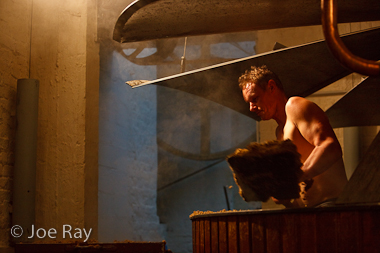
Spontaneous fermentation and vintage methods make lambic beer reminiscent of another time and good times
BRUSSELS, Belgium—Belgium is boring.
That was the preconception. Then I remembered: great fries, friendly people, beautiful architecture, and beer that makes aficionados drool.
What was I thinking?
I grab a cone of fries and head to a brewery where I begin to understand why beer, particularly lambics - “wild beers’’ that are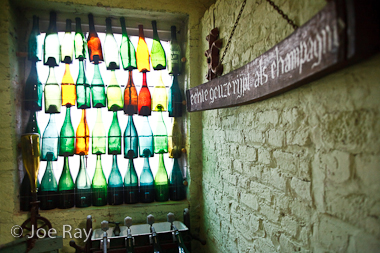
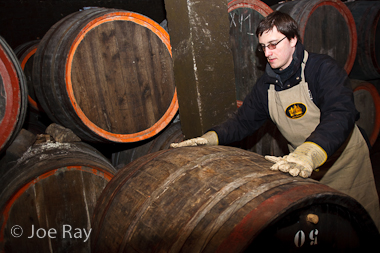
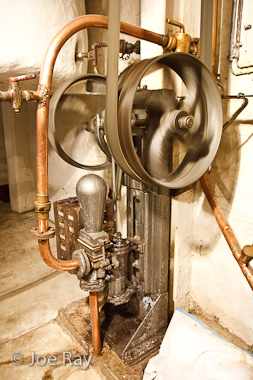
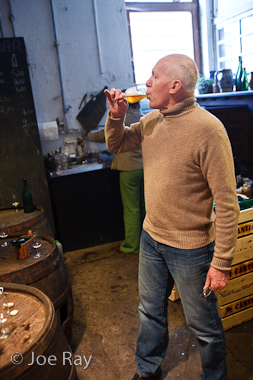
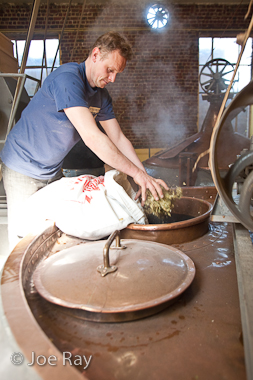
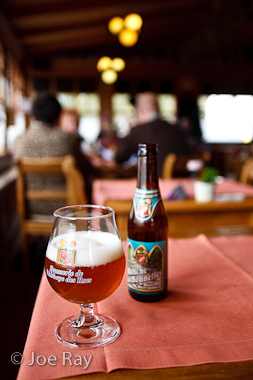
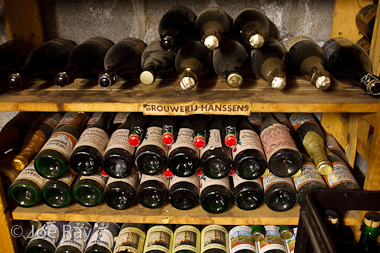
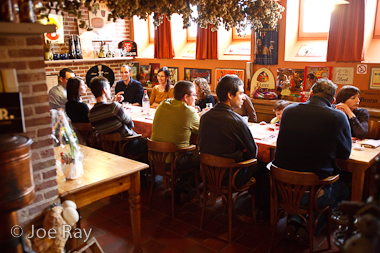
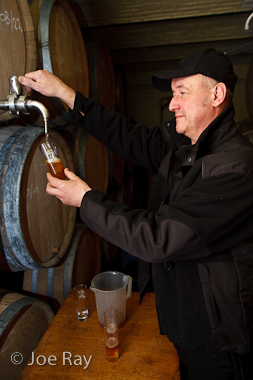
products of “spontaneous fermentation’’ and aged for three years in oak barrels - runs in Belgians’ veins.
“There was a choice, and then again, there wasn’t a choice,’’ says Jean Van Roy, who, along with his semiretired father, Jean-Pierre, runs the Cantillon brewery, which was founded in 1900 and calls itself the last traditional brewery in Brussels. “My parents worked so hard to bring it back that, psychologically, I couldn’t do anything else.’’
The machines and methods used at Cantillon are decades and even centuries old and create beers that have blissfully little to do with the mass-produced brews that line the world’s supermarket shelves.
On a production day, light streams through the window, people work in overalls, and steam collects in drips on the ceiling. The tiny facility is a perfect way to understand how beer is made.
To begin, huge quantities of crushed wheat and malted barley are given a hot-water bath in a giant wooden tub, creating a heady-smelling liquid called wort, but this is where the similarities between lambic and mass-market beer end.
Aged hops - more of a preservative than a flavoring agent for lambics - are added and the near-boiling liquid is pumped upstairs to catch a cold. In a shallow copper vat known as a cooling tun that’s nearly as large as the drafty, musty room it’s kept in, the wort is exposed to the elements, particularly the wild yeasts native to Brussels’ Senne Valley (especially Brettanomyces bruxellensis and Brettanomyces lambicus) and perhaps others unique to the brewery itself.
Inoculated with the wild yeasts that will kick-start the fermentation process and turn this water into beer, the liquid is aged in winery-style oak barrels for up to three years, at which point the barely-fizzy brew can legally be called lambic.
“We’re not really trying to do it for effect, but it’s what the beer needs,’’ says Van Roy, who catches me staring at a hundred-year-old engine that’s connected by long belts to almost every machine in the production rooms.
“That’s the heart of the brewery,’’ he says, but instead of sounding worried that the antique’s performance is vital to his weekly paycheck, there’s an assurance that it is.
The family-run brewery embodies a definition of honest work and an honorable trade that are lost in time. Watching it happen, I realize that beer, the good stuff, is a link to tradition and the city’s postwar heyday.
Jean-Pierre Van Roy grew up in that period and has been gently reminding people of that way of life since he took Cantillon’s reigns in 1969.
“Belgium is a memory. Everything is a memory. It’s when I met my wife and studied and there was an ‘esprit national,’ but when I started working here, you wanted to hang yourself,’’ he says. “I remember being in my car and seeing people heading to work looking miserable.’’
It’s a reminiscence, a critique, and a gentle call to keep the heart and mind open. “The idea isn’t to live 100 years, but to take advantage of our time and what we do,’’ he says. “That’s what reigns here. That’s my Brussels. It doesn’t just happen.’’
Following a tip and inspired by sunny weather, I go off the map to find that feeling and head to the Saint-Gilles square, a terrace-lover’s paradise ringed by cafes and bars, each with its own personality and unique clientele.
Farther uphill, I find a diamond in the rough, Chez Moeder Lambic, a bar with perfect beer, local (and often raw) cheeses with suggested pairings, a surly staff, and a feeling of being in the thick of the good stuff. There may be better-known places in the center of town, but it’s out here that things begin to click around a glass of the local brew. The thriving city Van Roy remembers might be harder to find than it was a few decades ago, but it’s still here.
To understand the art of the blend, taking what’s in the individual lambic barrels and turning it into the finished product, I turn to Armand Debelder at 3 Fonteinen brewery in Beersel.
“Forget what you know about brewing,’’ he says. “There’s no science. There’s never anything exact about wild fermentation. As soon as you start talking about lambic, you’re talking about something else.’’
I mention winery and distillery blending rooms where scientific approach meets personal taste and Debelder quickly throws logic out the window.
“You can’t make these beers happen automatically. Experience is all that’s important,’’ he says. “When I taste something, I know.’’
Lambic takes some getting used to and has very little to do with a cold draft from the local bar. The brew tends to be served at room temperature and, after three years in a barrel, is just about flat. Get over those humps, however, and savor green apple and grapefruit aromas and flavors and a thirst-quenching quality that is second to none. Mix younger versions of the beer and you’ve got a fizzy gueuze. Macerate sour cherries in your lambic or gueuze for a very tasty kriek.
We try Debelder’s 2005 Oude Gueuze and, like with a glass of wine, we stare, swirl, and sniff. It’s got a coppery color and, at first, a smell like his brewery’s barrel room: neither good nor bad, but honest and surprising with an immediate sense of place.
“Never be influenced by your first influence,’’ Debelder counsels, Yogi Berra style. “You’ve gotta let it sit for a minute.’’
Sure enough, a beautiful smell of the grain, reminiscent of the wort it once was, is revealed.
“Everything takes time,’’ he says. “Take a first sip and coat your mouth, then wait a minute and take a second sip. Then you can pay attention.’’
A sip reveals grainy notes followed by characteristic green apple and grapefruit flavors. His kriek reminds me of a trifle dessert I made as a kid. Both have deeper qualities that make me think of the friends I’d like to share it with.
For the coup de grace, I follow foodie and purist leanings and head out of town, coupling a train ride to Liedekerke with a 20-minute walk to De Heeren Van Liedekerke, where Joost de Four, his wife, Jessie, and brother Tom (the restaurant’s award-winning chef) and infant daughter, Helena, host a nonstop flow of local guests and pilgrims drawn by an impressive stock of 350 beers and 200 vintage and Trappist brews including specialty blends made just for him.
“People love the variety and we know how to explain what they’re drinking,’’ says de Four who, along with being an official “beer ambassador,’’ has invested the mammoth amount of time required to visit almost every producer he stocks.
While de Four takes care of customers, I sip a Blanche des Honnelles dubbel wit, “from Montignies-Sur-Rocs,’’ he adds. It has a deep, long-lasting flavor that ranges from yeasty to spicy. Around the restaurant, large families gather at long tables for lengthy meals and an old couple stops in for a pint, a coffee, and a little plate of cheese, everyone connecting with each other and pulling traditions further into the present.
Back at Cantillon, Jean Van Roy shovels tons of wet wheat and barley into a cart that will be taken away and used by a local farmer. It’s slow and backbreaking work and someone comes by to ask if he wants a glass of water.
“Are you kidding?’’ he replies. “When I’m done, I want a beer.’’